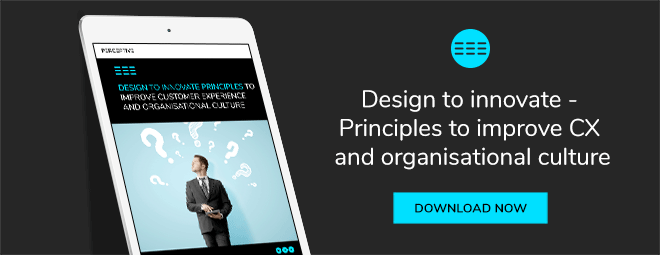 Design thinking (DT) doesn’t just drive innovation and help businesses understand the journey of their customers, it also facilitates a customer-centric culture. It’s is a natural byproduct of implementing DT practice throughout your business.
Design thinking (DT) doesn’t just drive innovation and help businesses understand the journey of their customers, it also facilitates a customer-centric culture. It’s is a natural byproduct of implementing DT practice throughout your business.
Applying design thinking principles to your business
Many organisations around the world are applying DT principles to the way they work on a daily basis. Many modern businesses are a complex tangle of systems, processes and technology. Adopting DT can help clear the air and find fresh solutions to old problems. This can manifest in different ways and be a multi-faceted approach. Essentially, it's all about problem-solving in more than one way to survive and thrive.
While it seems complicated, DT is about simplifying complexity. It’s a great tool for creating a flexible organisational culture as it focuses on the human nature of business and uses empathy to solve problems.
From a customer perspective, a shift to a design-centric culture will, in effect, improve their experience too as DT’s core focus is on user experiences and building empathy with them.
Related content: Identify the moments of truth in your customer journey
1. It builds empathy
Design thinking begins with empathy—and observation. Businesses observe behaviour to understand and define what their customers wants and needs are. Without this step, they could create a product that is meaningless to the user.
Even as your team builds, tests and implements ideas, it all comes back to empathy: are they meeting their users’ needs? Emotional thinking drives this process; to succeed they must understand the user’s desires, engagement and experience. This type of thinking is expressed in emotive language, not quantitative, meaning your team will consider and discuss the emotional resonance and impact of an idea just as much as its utility and product requirements.
Related content: Innovate your business with design thinking
2. It ensures your ideas will succeed
Innovation leader, MIT Media Lab, has a motto that perfectly sums up its customer-focused culture: "demo or die". Creating prototypes and pilots to test new ideas and product is a vital part of any design-centric business. Understanding your customers and their journey map will explore the problem itself, but a prototype or pilot will explore the solution (or solutions). It is a great way to validate the idea to see if it is fit for the user—which is valuable in and of itself.
Trying out your ideas, reiterating until you find the right one, and failing fast is a highly innovative process. Prototyping is the most pragmatic thing innovative businesses can do to test out their ideas.
3. It creatures a fearless culture
By its nature, design thinking rarely, if ever, gets things right the first time—and that’s okay. Businesses that adopt this way of working accept this, and nurture a culture where failure is accepted.
For example, rocket company SpaceX failed repeatedly in their question to develop the Falcon 9 rocket. Yet, now they have perfected the first self-landing rocket in history. To quote SpaceX founder, Elon Musk: “Failure is an option here. If things are not failing, you’re not innovating hard enough.”
In a culture that recognises that failure is simply part of the process, people aren’t afraid of getting it wrong, meaning they dare to think bigger, to strive further. Failing is seen as learning. It’s the byproduct of innovation.
4. It helps build simple, effective products
As with many things in life, simple often is better; less is more. Products that are built on emotional value propositions are often clean and simple (think Apple). Restraining your products to offer only the most beneficial, powerful value-features (without overcomplicating) will often reap the greatest reward.
Businesses that create simple products make just as many deliberate decisions about what a product should not do as to what it can do.
"Peeling off" unnecessary features can offer a clear and simple experience for your customers. CEOs have to act like a bit of an editor and maintain a constrained focus instead of adding more features just for the sake of it.
5. It creates a flexible and efficient workplace
Every touchpoint your company has with a user shapes their impression of you and your brand. When your company culture focuses on customer experience, these touchpoints are naturally designed to meet user needs first, rather than internal operational efficiencies.
Design thinking puts the customer at the core of everything—especially when your staff come together to problem-solve as a team. DT places great emphasis on getting different perspectives, which encourages a cross-functional blending of teams. This helps to uncover fresh ideas, break down silos as well as preventing any one group from favouring a solution that benefits them rather than the customer.
Additional bonus: this style of problem-solving also highlights the individuals in your teams who are "on to it". They tend to be quick-thinking individuals who ask lots of questions and are able to break down boundaries without needing management to intervene or prompt. These team members are great at identifying solutions, as they are all about creating excellent customer experiences.
Learn more about how design thinking can improve your customer experience, and how to develop a customer journey map, by getting our free eBook below.
